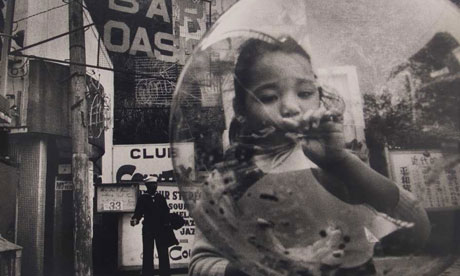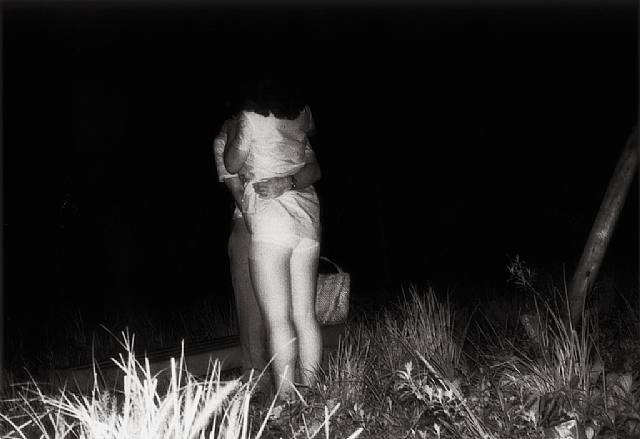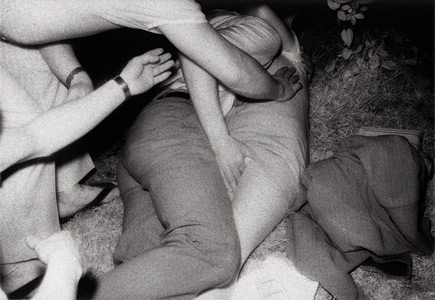
The Provoke Era: SFMOMA Photography
Provoke, was the Japanese magazine and collective founded in November 1968 by a group of photographers and critics including Koji Taki, Takahiko Okada, and Takuma Nakahira (b. 1938), joined by Daido Moriyama in the second issue. The magazine folded in August 1969 after only three issues. With a radical, leftist bent, it aimed to counter established viewpoints, publishing blurry, gritty photo-essays and critical new ideas. The history and demise of the magazine were discussed in the book Mazu Tashikarashisa no Sekai o Sutero (First Discard the World of Pseudo-Certainty (1970)), after which the collective disbanded. Its influence, however, persisted. Mariko Takeuchi.
By the late 1960s Japan was enroute to establishing itself as an economic power – if not yet become a superpower. The country hosted American military bases, occupation remnants retained as a bulwark against the communist threats of Russia and China, not to mention support of the American war in Vietnam. The democracy established under occupying U.S. General Douglas MacArthur allowed a multiplicity of political expression. But economic life, the real social determinant, was crushingly conformist. “Zaibatsu” conglomerates organized in quasi military fashion, demanded complete social participation by their employees down to organized weekend activities and vacations. Office girls often moved into arranged marriages in the corporation.
Underground expression became the outlet for artists seeking escape from a destiny of following traditional art forms and standardized work life. The Provoke photographers broke out to challenge fine photography traditions of composition, finish and subject matter. Are-bure-boke (“rough, blurry, out of focus”), a coinage, applies not just to the quality of their pictures but to what they shot. A lot of the time they chose social outcasts; whores, bums, transvestites, eta. Or, in the case of Hosoe Eikoh, Butoh dancers. Or, the photographers subverted the ordinary to the cause of liberation; two schoolgirls on a ferry in their sailorsuits headshot from behind, hair blowing out of control.

Photographer Yoshiyuki Kohei (above) trawled Tokyo parks by night, or some temple precinct with couples making out in the bushes – taking pictures while others watched.
This summertime petting zoo in the humidity was a group activity with distinct modes of participation:
Gender mode: boy and girl. Active/passive mode: add the voyeur. Activated mode: gropers entwine the couple. Consumer mode: Buy the picture magazine Provoke.
How did Yoshiyuki get his night lighting? Infrared film. The couple on the ground (below) is a cool duet generating heat, pulling together the act on their hormonal nickel. Communal yet alienated, the milieu of Shinjukus Golden Gai was where photographers artists and intellectuals mingled with the demimonde and yakuza in an old red light district that had been converted to tiny bars. The neighborhood was the floating world. Transvestites dressed as geisha beckoned you out of the night.

During the PROVOKE era the practices ritualized the subculture. Watanabe Katsumi shot the chimpera – punks in Sinatra sharkskin striding in the city rain. Participatory defiance / object of desire. Hosoe Eikoh recorded Butoh dance and ghost clown Hijikata Tatsumi, a leader of the only new artform to develop in Japan after World War II. How many cultures develop a new art after a catastrophic military tragedy? On the wall of SFMOMA youll see the wound that catalyzes this show, the keloid-scarred hibakusha, people burned by the atom bomb, photographed by Tomatsu Shomei.
Hosoes pictures are more aestheticized than the others. Butoh may have been revolutionary but I know of at least one dancer who had a Butoh company and had to moonlight as a stripper to survive, moving all the time. As Ushio Amagatsu, leader of Sankai Juku (Butoh troupe) said, “the avant garde is a passionate love affair with tradition.” The old Japan meets the new Japan in the art of the wound, not necessarily of healing. The new skin telegraphs the distorted flesh it grafts.
I cannot really see a photograph as a singular art work that can be shared. My work may serve as a document due to its unique character-but only for my self, since I can never take photographs on behalf of others. So in this sense, I am a quintessentially amateur photographer. To put it another way, it is not societal but personal work that leaves a sense of emptiness, whether it is made by someone who happens to be famous or by someone who is anonymous. Even so, I am compelled to continue aiming my camera at such emptiness, because it is in these congeries of emptiness that the spaces between historical events are filled. – Daido Moriyama.
